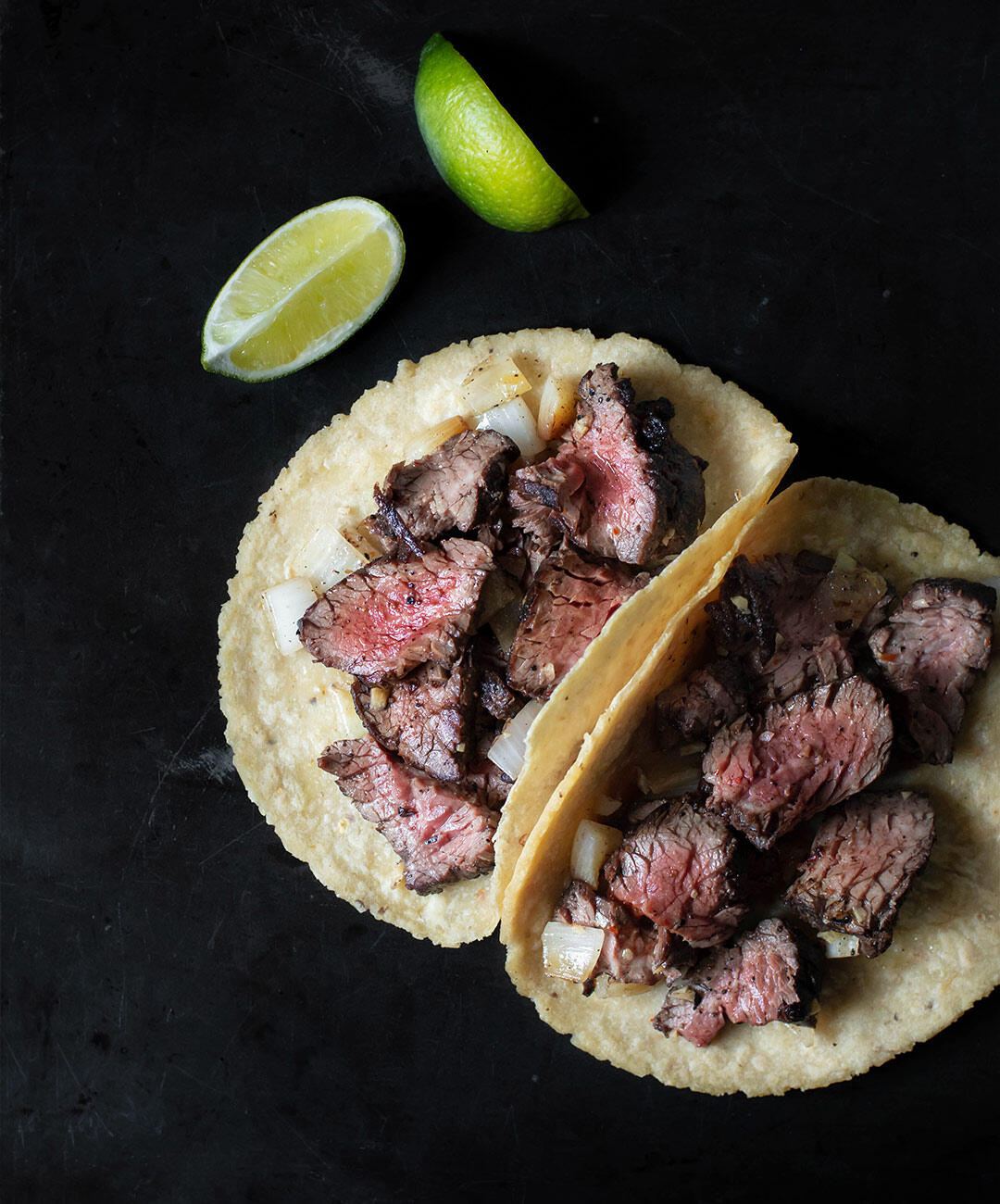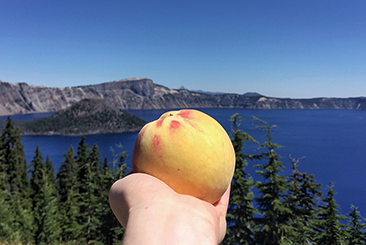Steak Tacos with Mojo de Ajo

My mind was set on making tacos one Saturday so I bought the meat and tortillas and figured whatever produce was in the kitchen would suffice for toppings. I then went sauce hunting through my cookbooks and hit upon Alex Stupak’s Steak Tacos with Mojo de Ajo in his aptly named book, Tacos. After adding some scratch Pico de Gallo to the mix, dinner was sorted.
Mojo de Ajo is basically finely chopped Garlic Confit hopped up on spices and citrus juice with a little tomato thrown in for good measure. It's extremely versatile and, as it turns out, can really make a dish. Little did I know that Mojo de Ajo was the missing ingredient for my Calabrian sausage, onion, and green pepper pizza. I’ve already squirreled some of this new-to-me liquid gold away in the freezer to ensure that it's always on hand.
Included in this post are detailed instructions as well as an extended section on the difference between hanger, flank, and skirt steak (the former being used in the recipe). Know your meat. The tacos are pictured without Pico de Gallo so if you need a visual just check out that recipe.
It's mid-October and 80°F here in Santa Monica so might as well keep grilling. Fall weather and scarves are so 1900s.

Useless Facts
Hanger vs. Flank vs. Skirt
I’ve worked with skirt steak a few times but have yet to be happy with the results. I understand cutting against the grain, marinating, etc., but the texture and finished product just never quite do it for me. Perhaps it's user error, really not sure. Then I made Nancy Silverton’s Beef Tagliata from her cookbook, Mozza, which called for hanger steak. This cut of meat (not to mention the dish) was a winner so now I always swap in hanger for skirt as I did with these steak tacos.
I was curious about my preference for one cut over the other so I called Alice at A Cut Above Butcher Shop and asked her to explain the difference between hanger (aka the butcher's cut), skirt, and flank steak. Here is a summary of what she shared supplemented by a small spin through The Google. Hopefully I kept it all straight.
Location, Location, Location
The skirt (there's actually an outer skirt and inner skirt), hanger, and flank all come from the lower belly region known as the "plate" and "flank". This illustration helps.
- Hanger or The Butcher's Cut - Sits close to the kidneys and gets a lot of blood flow which enhances its meaty flavor. This cut hangs off the loin and isn't really a working muscle. The relative lack of movement contributes to hanger steak's tender texture and it has the best marbling of the three. All of these factors help explain why I'm partial to it.
- Inside skirt - What most people know as skirt steak. It sits on the inside of the ribs and close to the lungs. Skirt has more marbling than flank but less than hanger. It's also a harder working muscle meaning the texture is tougher relative to hanger.
- Outside skirt - Tougher than both of the above and comes from the riblets of rib cage. Apparently restaurants are partial to this cut because of its size.
- Flank - Comes from the belly-ish area but is technically in the loin area. Flank steak has less marbling than both skirt and hanger and is also a working muscle meaning the texture will be tougher.
Love me Tender
I originally thought that both skirt and flank steak enjoyed a good marinade because it helped tenderize the meat before cooking. Here's a page that dispels myths about marinating (i.e. I was wrong). A marinade will add flavor to all of the cuts mentioned above but won't make them tender. Even Wikipedia gasp suggests that marinating the meat helps reduce toughness. Food science suggests otherwise. This comic hits upon how I feel when the Internet tries to confuse me.
All three cuts like to be cooked hot and fast so as to develop a good char without overcooking the interior.
Whichever Way You Slice It
A make or break step in terms of texture is to cut hanger, skirt, and flank steak against or across the grain. The best analogy I've heard is to think of tying 20 hoses together in a bundle, the hoses being the fibers of the meat. If you cut that bundle lengthwise and try to take a bite, you'll be tugging at the tubes (or fibers). If you cut a small portion off the end of the bundle or across the hoses, it will fall apart nicely. Same idea with the meat. Hanger, skirt, and flank steaks also like to be cut relatively thin.

Original vs. Adapted
Onions
The cookbook calls for cutting the onions into “3 thick slices” before putting them on the grill. My onions were on the smaller side so I opted to just cut them in half and blacken both sides. Slicing the onions allows for more of the surface area to char which is desirable so if you have larger onions by all means go with the cookbook's instructions. I plan to do that in the future if possible.
Fixins
Chef Stupak calls for Salsa Arriera (serrano, garlic, white onion) but I went with some freshly made Pico de Gallo since that's what I had on hand. The latter is also a recipe from Tacos and paired perfectly with this meal. Very easy to make.
Recipe Tips
Sort of Slow and Steady
When simmering the garlic and oil, don’t let it get brown or cook at too high of a heat. The color of the garlic should slowly come up to a light golden shade. With that said, you don’t have to crawl on the lowest flame or the sauce may take forever to come together. I bring the oil to a lazy bubble over medium heat and then continue cooking on medium-low. When cool, the texture of the Mojo de Ajo should melt effortlessly into whatever dish it’s added to.
...Then Hot and Fast
Getting a nice char on the onions and meat while not overcooking them requires a hot grill. It’s difficult to provide precise instructions for this other to say that you’re aiming for a medium-rare or low end of medium center while still getting those delicious seared bits on the outside. If the grill's heat is too low, the center will cook up before the desired flavor and color is developed on the surface.
Tortillas
The next best thing to whipping up your own tortillas is to buy from a local shop or restaurant that makes and sells them. If your only option is the grocery store, look for tortillas that seem fresh and have to be refrigerated. Those are usually the ones that you have to "cook" in a cast-iron skillet. Generally speaking though, grocery store tortillas are a waste of time and money. For Los Angeles residents, check our KCRW's Gustavo's Great Tortilla Tournament. The bracket at the bottom of the page lists numerous excellent resources.

Heirloom Garlic at Milliken Family Farm - Santa Monica Farmers Market
Farmers | Artisans
I make an effort to source my food from California artisans with a special focus on the Santa Monica Farmers Market. Below is a list of the folks who contributed to this dish.
- Milliken Family Farm / Heirloom Garlic
- Tutti Frutti Farms / White Onions
- Coleman Family Farms / Pomodoro Tomato
- Polito Family Farms / Limes and Oranges
- Trattore Farms / Olive Oil
- A Cut Above Butcher / Hanger Steak
Ingredients (From Alex Stupak's Cookbook, Tacos - makes 10 to 12 )
Mojo de Ajo
- 1 cup olive oil
- 20 garlic cloves (approximately 65-70 grams after peeling), minced
- 1 pomodoro or Roma tomato, deseeded, stem removed, diced (110 grams or 4 ounces - measured after prep)
- 3 ounces (85 grams) freshly squeezed orange juice
- 2 árbol chiles, stems removed, chiles gently rolled to remove seeds (discard seeds) Update: I increased this to 3 in a recent version. If you like spice then I recommend it.
- 1/2 teaspoon whole peppercorns
- 1/2 teaspoon dried Mexican oregano
Tacos
- 1 ½-2 pounds hanger steak (about 2 pieces), cut crosswise into 2 or 3 pieces for easy handling.
- 2 small white onions, cut in half, outer skin removed Note: See "Original vs. Adapted"
- 2 limes, cut into wedges
- Corn tortillas
- Pico de Gallo
Instructions
Mojo de Ajo
- Combine 1 cup olive oil and the minced garlic in a small non-reactive saucepan.
- Cook the mixture over medium or medium-low heat until the garlic is light golden. Swirl or stir frequently. Note: See “Recipe Tips”
- While the garlic is working, heat a cast-iron skillet over medium heat for 5 minutes. Add the chiles, peppercorns, and oregano, then shake continuously for 15-20 seconds. The mixture will be fragrant almost immediately. Transfer to a bowl to cool.
- Grind the spices.
- Once the garlic is a very light golden color, add the tomatoes, orange juice, and ground spices to the oil and continue to cook on a low temperature until the tomatoes start to break down. At no point should the garlic be more than golden brown.
- Set the oil mixture aside to cool.
- MAKE AHEAD - If you’re making the steak tacos a different night, cool the Mojo de Ajo and then refrigerate in an airtight container. Per Tacos, the flavored oil can be stored this way for several weeks if cooked properly. I only kept the Mojo de Ajo in the fridge for a few days and then froze the leftovers.
Steak + Onions
- Get the grill working at a relatively high temperature. Note: See “Recipe Tips”
- Rub the onion halves and steak in 4-6 tablespoons of just the oil from the Mojo de Ajo and then generously season with salt and freshly ground pepper. Note: Really lean on that pepper - it's hard to overdo it.
- Grill the steak until it's medium-rare and set aside under a loose foil tent. That carry-over cooking can increase the doneness so keep that in mind. I like the low end of medium so the carryover cooking works well for me.
- Cook the onions until well charred.
- Chop the onions into bite-size pieces and set aside.
Serve
- Heat your tortillas in a cast-iron skillet and set aside under a towel to keep them warm.
- Cut the steak in half lengthwise, then cut into thin pieces against the grain.
- In a medium bowl, toss the chopped onions and steak with a few tablespoons of the Mojo de Ajo (both the garlic bits and oil).
- Taste, then adjust the Mojo de Ajo and salt until the flavor is to your liking. I ended up adding more of both.
- Top the tortillas with some of the meat and grilled onions, pico de gallo, and some freshly squeezed lime juice.







